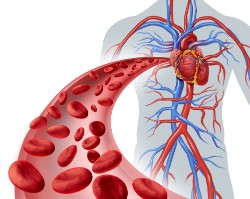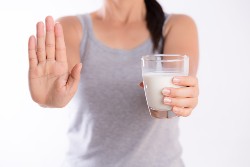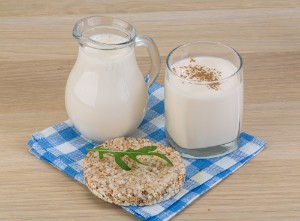How is milk useful to an adult's body – 7 scientific facts
 Animal milk has been consumed by humans for thousands of years.
Animal milk has been consumed by humans for thousands of years.
Recently, the debate about the benefits of milk and dairy products in general has become much more frequent. They say that milk is only needed by children, and drinking it for an adult is unnatural, and can even be harmful to health.
Nevertheless, milk has been subjected to numerous studies, according to which it has many reliable beneficial properties, including for adults.
And the myth of its harm is related to the fact that, on average, every fourth inhabitant of the planet has a certain degree of lactose intolerance. It is precisely these people who should limit or completely exclude the product from the diet.
Milk is high in calcium and vitamins. According to various studies (links to them will be further in the article), the product helps to strengthen bone tissue and maintain oral health. Milk also reduces the incidence of cancer and cardiovascular diseases, saturates the body with a variety of essential amino acids.
The need for milk constituents is significantly increased in children and elderly people.
Content
7 proven properties
The main beneficial properties of milk are due to the content of a wide range of valuable nutrients: proteins (including essential amino acids), fats, calcium, phosphorus, magnesium, potassium, selenium, vitamins (D, B2, B12, A).
Below are 7 proven facts about the benefits of milk for the body a human being.
1. Saturates the body with protein
 1 cup of milk (200 ml) contains almost 7 grams of protein. Milk protein contains many valuable amino acids that are used by the body as a "building material".
1 cup of milk (200 ml) contains almost 7 grams of protein. Milk protein contains many valuable amino acids that are used by the body as a "building material".
According to research, proteins are necessary for the growth and reproduction of all cells, regulation of the immune system, and increasing the body's resistance to various infectious agents of viral or bacterial etiology.
Scientists claim that protein is especially important during periods of intense physical or mental stress . It is also necessary for athletes to increase muscle mass.
Milk contains two main types of proteins: casein (70-80%) and whey protein (20-30%). Both belong to the high-quality class. The composition of whey protein includes such essential amino acids (their body cannot synthesize on its own):
- Valine;
- Leucine;
- Isoleucine.
With their deficiency, a significant complex of disorders develops in the body: from chronic fatigue and a decrease in immunity to a serious dystrophic lesion of internal organs.
2. Supports the health of the musculoskeletal system
 The use of cow's or goat's milk has been associated since ancient times with Bone health
.
The use of cow's or goat's milk has been associated since ancient times with Bone health
.
Milk contains calcium, potassium, phosphorus, vitamin K2, as well as a lot of protein. It is these components that ensure the normalization of mineral metabolism in bone tissue, reduce the risk of osteoporosis and fractures.
This feature is extremely important for men and women after the age of 50 due to progressive involutive changes in the musculoskeletal system.
Milk also contains vitamin D and magnesium, elements that increase the bioavailability of calcium in the intestine. Therefore, for various diseases of the bone system, it is recommended to take calcium supplements with dairy products.
Italian scientists have proved that low consumption of milk and dairy products is directly associated with the development of osteoporosis, as well as a number of cardiovascular diseases (hypertension).
Similar results described by Polish scientists . The researchers also claim that osteoporosis affects about 30% of women and 8% of men over the age of 50. This group of people is recommended to take milk on a regular basis (1-2 glasses per day).
Milk, in view Bone strengthening and high calcium content, has a beneficial effect on tone and metabolism in skeletal muscles. Muscle tissue works more actively in the process of contraction Ligament and tendon tissues are strengthened .
3. Helps to normalize body weight
 According to the latest data, regular intake of milk and low-calorie dairy products reduces the risk of obesity and promotes weight loss.
According to the latest data, regular intake of milk and low-calorie dairy products reduces the risk of obesity and promotes weight loss.
One of the major scientific studies revealed that milk consumption provides reliable prevention of obesity (with initially normal body weight) in middle-aged and elderly people.
It is important to note that even the high fat content in the drink does not have a negative effect on lipid metabolism in the human body.
According to Australian scientists, the consumption of milk contributes to the rapid saturation of the stomach and the development of a feeling of satiety.
The drink accelerates the secretion of digestive juices of the pancreas, which improves the digestive processes and significantly increases the energy value of the food supplied to the body. Milk can be consumed in the morning for breakfast, as well as at night.
Milk contains a significant amount of conjugated linoleic acid which, according to research papers , it is able to increase the rate of cleavage of adipocytes for various energy needs of the body and block the deposition of new portions of fat.
4. Reduces the risk of developing cancer
 Recently, colorectal cancer has become widespread – a malignant tumor of the colon and (or) rectum. About 50,000 new cases of the disease are registered in Russia every year. According to statistics, pathology remains unrecognized until the end of life in 30-40% of cases.
Recently, colorectal cancer has become widespread – a malignant tumor of the colon and (or) rectum. About 50,000 new cases of the disease are registered in Russia every year. According to statistics, pathology remains unrecognized until the end of life in 30-40% of cases.
Scientific studies demonstrate that taking whole goat's or cow's milk significantly reduces the risk of developing colorectal cancer.
For example, scientists from the UK claim that the consumption of milk, as well as a number of other dairy products (with the exception of cheese), leads to a 7.5 – 10% reduction in the risk of colorectal cancer.
In this case, the main role is played not only by antioxidant substances, but also by calcium. According to scientists , calcium intake not only reduces the incidence of malignant tumors, but also significantly reduces the likelihood of recurrence.
In addition to the described substances, milk contains vitamin D. According to research conducted in France , the incidence of colorectal cancer is inversely proportional to the concentration of vitamin D in blood plasma.
Milk fats, according to Australian scientists , contain a number of anti-carcinogenic components (essential lipids, butyric and linoleic acids, sphingomyelin) that block malignant cell division. Studies conducted "in vitro" demonstrate that the described substances block the proliferation of malignant cells, cause apoptosis, and prevent the appearance of paraneoplastic processes in the body.
5. Supports the health of the cardiovascular system
 As already mentioned, milk strengthens the cells of muscle tissue and helps to reduce the volume of adipose tissue in the body. Such properties reduce the risk of developing cardiovascular diseases.
As already mentioned, milk strengthens the cells of muscle tissue and helps to reduce the volume of adipose tissue in the body. Such properties reduce the risk of developing cardiovascular diseases.
According to scientific research, milk consumption is inversely associated with the overall risk of heart disease, but does not affect overall mortality and life expectancy.
It is important to note that the drink helps to increase the concentration of lipoproteins with high (beneficial) and low (harmful) specific gravity, reduces total cholesterol (by inhibiting the formation of triacylglycerides). The described effects are the subject of multiple scientific disputes, but they have a positive effect on the human body rather than a negative one.
6. Promotes the prevention of type II diabetes mellitus
 Dairy products (by activating lipolysis) increase the sensitivity of insulin receptors located on the surface of fat and muscle tissue cells, as well as normalize glucose and insulin metabolism.
Dairy products (by activating lipolysis) increase the sensitivity of insulin receptors located on the surface of fat and muscle tissue cells, as well as normalize glucose and insulin metabolism.
Employees of Suzhou University (China) claim that daily addition of low-fat milk to the diet provides reliable prevention of type II diabetes mellitus.
7. Strengthens teeth
 Milk is one of the main sources of calcium and phosphorus for the human body. Up to 99% of calcium is deposited in bone tissue and tooth enamel.
Milk is one of the main sources of calcium and phosphorus for the human body. Up to 99% of calcium is deposited in bone tissue and tooth enamel.
Foreign studies have found that children who do not have milk in their diet (for various reasons) are more likely to have caries, a higher risk of premature tooth loss and weaker gums.
Processing types and the difference between them
 Modern industry has developed and successfully applies many methods of milk processing. To extend its shelf life, temperature treatment is used.
Modern industry has developed and successfully applies many methods of milk processing. To extend its shelf life, temperature treatment is used.
However, such a temperature treatment destroys all bacterial flora, including those useful for humans.
Below we will discuss the most popular methods of milk processing, as well as tell you how this or that method affects the beneficial properties of the product.
- Pasteurization. There are two types: low-temperature (heating up to 76 degrees) and high-temperature (from 77 to 100 degrees). Within such a framework, a significant part of the useful substances is preserved, almost all microorganisms (with the exception of spores) die. This product, even in an airtight package, is stored for several days.
- Sterilization. Sterilization is similar to ordinary boiling and is the effect of high temperatures (100-110 degrees) for 20-30 minutes. Such milk is absolutely sterile, the concentration of vitamins and other useful substances is reduced by about 3 times, but the duration of storage increases.
- Ultra-pasteurization. With this method, the milk is aged for several seconds at a temperature of about 140 degrees. This period of time is sufficient for the death of all living cultures of bacteria and fungi. Ultra-pasteurized milk has greater benefits compared to sterilized milk.
- Cooling. At temperatures from 25 to 37 degrees, the bacterial flora actively processes carbohydrates contained in milk, which negatively affects the taste of the drink. Cooling of the product slows down the vital activity of microorganisms, blocks the work of enzymes in their cells, which leads to an improvement in the organoleptic properties of the drink. This method is most common in everyday life and has practically no effect on the properties of the product.
- Freezing . Milk is usually immersed in an environment with an air temperature of -15 degrees. Under such conditions, the product remains usable for 1-1.5 years, but valuable fats and vitamins are destroyed.
Also, during industrial processing, milk undergoes normalization – reducing the concentration of fat by separating cream, or degreasing – almost complete removal of cream from whole milk.
Skimmed milk is recommended for people who are obese and have a high risk of developing cardiovascular complications. The rest of the people should give preference to whole (full-fat) milk.
Condensed milk should be singled out separately – concentrated milk with sugar, which is devoid of almost all the positive qualities of ordinary milk, but has significant harm due to the high content of added sugar.
A few words about lactose intolerance
 No matter how positively milk affects most people, it cannot be consumed by certain categories of people.
No matter how positively milk affects most people, it cannot be consumed by certain categories of people.
The most common contraindication is lactose intolerance is a pathological syndrome in which the body produces an insufficient amount of lactase, an enzyme that ensures the breakdown and assimilation of lactose.
The prevalence of pathology is extremely high. On average, every fourth inhabitant of the planet is lactase deficient. In some regions of the globe (China, South Africa, South America), the incidence of the pathological condition reaches 80-100%.
The development of intolerance is (predominantly) genetic in nature and is inherited from generation to generation. It is less common against the background of various acute or chronic atrophic lesions of the duodenum, as well as after surgical removal of the organ.
If a person suffering from lactose intolerance consumes milk, the following symptoms may develop:
- Stool disorders (more often – diarrhea, less often – constipation);
- Flatulence;
- Nausea and vomiting;
- Dehydration;
- Hypotrophy (if the condition remains unnoticed for a long time).
In order to correct the pathological condition, it is recommended to add lactic acid fermentation products to the diet :
Special dairy products are becoming more and more widespread, which generally does not contain lactose . Research is also underway regarding the separate intake of the lactase enzyme in the form of tablets.
Conclusion
Thus, milk is an extremely healthy drink for most people, containing many valuable vitamins, macro– and microelements. Its regular use (at least 1 glass every day) normalizes the digestive and endocrine systems, supports the mineral strength of bones and teeth, significantly reduces the likelihood of developing diseases of the cardiological and oncological profiles.
However, people with lactose intolerance should limit or exclude milk from the diet altogether.





